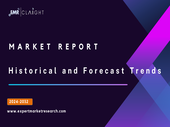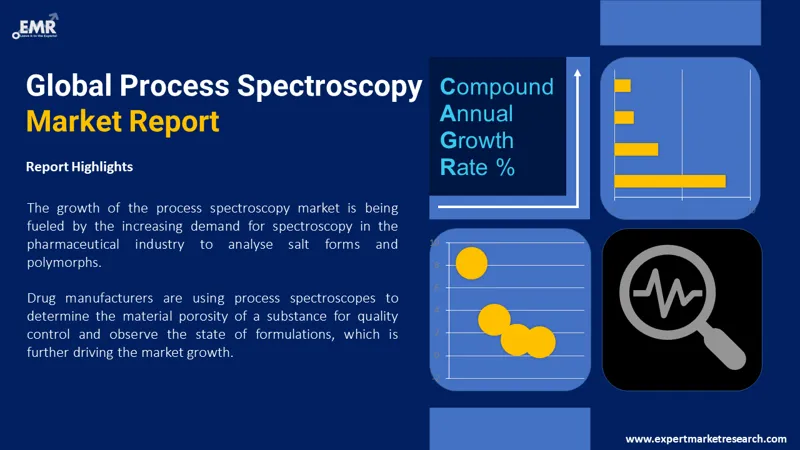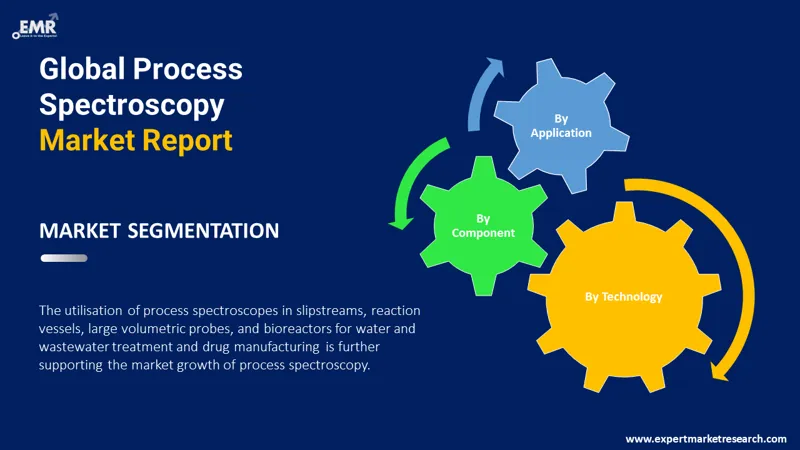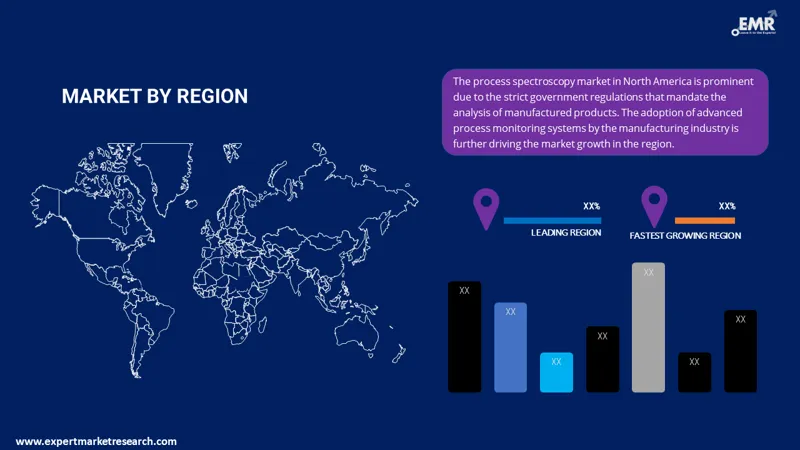Reports
Sale

Global Process Spectroscopy Market Size, Share, Growth, Trends, Forecast: By Technology: Mass Spectroscopy, Molecular Spectroscopy, Atomic Spectroscopy; By Component: Hardware, Software; By Application: Oil and Gas, Polymer, Metal and Mining, Water and Wastewater, Others; Regional Analysis; Competitive Landscape; 2024-2032
Global Process Spectroscopy Market Outlook
The global process spectroscopy market size reached a value of approximately USD 23.99 billion in 2023. The market is further expected to grow at a CAGR of 7.10% in the forecast period of 2024-2032, reaching a value of USD 44.48 billion by 2032.
Key Trends in the Market
Process spectroscopy is a technique that is used for analysis of interactions between matter, light, and electromagnetic radiations. It uses devices such as hyphenated and portable spectroscopes, display units and microscopes, amplifiers, and signal processors, among others. It is widely used in different fields of research and industries including food and agriculture, and pharmaceuticals.

Read more about this report - REQUEST FREE SAMPLE COPY IN PDF
- A key trend driving the growth of the process spectroscopy market is the growing demand of spectroscopy by the pharmaceutical industry. The pharmaceutical industry employs process spectroscopy for applications such as analysis of polymorphs and salts and for identifying the identity of a drug and examining its purity.
- The growing demand for process analysers in various end user industries including agriculture and food, among others, is another factor positively influencing the expansion of the process spectroscopy market. It is used for testing food and beverages and for ensuring the quality of major food groups including vegetables, meats, fruits, and dairy, among others.
- The rising utilisation of process spectroscopy in large volumetric probes, reaction vessels, bioreactors for wastewater and water treatments, and slipstreams is anticipated to provide impetus to the process spectroscopy market.
Market Analysis
On the basis of technology, the market is segregated into mass spectroscopy, molecular spectroscopy, and atomic spectroscopy, with molecular spectroscopy further divided by type into NIR, FT-IR, Raman, and NMR, among others. Based on component, the market is bifurcated into hardware and software. On the basis of application, the market is divided into oil and gas, polymer, metal and mining, water and wastewater, pulp and paper, pharmaceuticals, food and agriculture, and chemicals, among others. Based on region, the market is segmented into North America, Europe, the Asia Pacific, Latin America, and the Middle East and Africa.

Read more about this report - REQUEST FREE SAMPLE COPY IN PDF
The comprehensive EMR report provides an in-depth assessment of the market based on the Porter's five forces model along with giving a SWOT analysis. The report gives a detailed analysis of the following key players in the process spectroscopy market, covering their competitive landscape and latest developments like mergers, acquisitions, investments, and expansion plans.
- Bruker Corporation
- BÜCHI Labortechnik AG
- Sartorius AG
- Shimadzu Corporation
- Agilent Technologies, Inc.
- tec5USA Inc.
- Others
Market Share by Technology
Molecular spectroscopy, based on technology, is projected to witness significant growth in the process spectroscopy market in the upcoming years. This technology is used for investigating the electronic configuration of atoms in excited and ground state and for determining the chemical composition of unknown materials. Rising demand from chemical and petrochemical industries, among other industries is fuelling the usage of molecular spectroscopy.
Applications of molecular spectroscopy can also be found in food and beverage and polymer industries for qualitative and quantitative analysis and in nanomaterials and microplastics. In pharmaceutical industry, molecular spectroscopy is used for ensuring tablet content uniformity, and moisture and stability of lyophilised materials, among others.

Read more about this report - REQUEST FREE SAMPLE COPY IN PDF
Market Share by Region
North America is anticipated to occupy a sizable share of the process spectroscopy market over the forecast period. This is due to the presence of stringent regulations of governments in the region to ensure the quality of manufactured products. Furthermore, the expansion of the market is boosted by the adoption of advanced process monitoring systems by various manufacturing industries.
Meanwhile, the market for process spectroscopy in the Asia Pacific is anticipated to witness considerable growth due to rapid adoption of new technologies and innovations in the field of process spectroscopy. Growing availability of skilled workforce and rising research and development activities are further projected to aid the market expansion in the Asia Pacific region.
Competitive Landscape
Bruker Corporation is a scientific equipment manufacturing company that was established in 1960 and is headquartered in Massachusetts, United States. They are known for offering high value diagnostic and analytical solutions and high-performance scientific instruments. They cover a broad spectrum of applications in the field of research and development and ensure process reliability and quality in various industrial production processes.
Sartorius AG is a biotechnology research company that was founded in 1870 and is based in Lower Saxony, Germany. They are industry leaders and one of the fastest growing global life science companies that is devoted towards simplifying medical processes and the production of new medications. They offer a wide range of consumables and instruments for biopharmaceutical laboratories and industries, among others.
Shimadzu Corporation is a biotechnology research company that was established in 1875 and is headquartered in Kyoto, Japan. Shimadzu specialises in analytical and measuring instruments, thermal analysis and molecular spectroscopy, optical devices, life science lab instruments, optical devices, hydraulic equipment, material testing, industrial machinery, and non-destructive testing systems, among others. Their products and services are aimed towards advancing human health and increasing the safety and security of industrial processes.
Other market players include BÜCHI Labortechnik AG, Agilent Technologies, Inc., and tec5USA Inc., among others.
Key Highlights of the Report
| REPORT FEATURES | DETAILS |
| Base Year | 2023 |
| Historical Period | 2018-2023 |
| Forecast Period | 2024-2032 |
| Scope of the Report |
Historical and Forecast Trends, Industry Drivers and Constraints, Historical and Forecast Market Analysis by Segment:
|
| Breakup by Technology |
|
| Breakup by Component |
|
| Breakup by Application |
|
| Breakup by Region |
|
| Market Dynamics |
|
| Competitive Landscape |
|
| Companies Covered |
|
| Report Price and Purchase Option | Explore our purchase options that are best suited to your resources and industry needs. |
| Delivery Format | Delivered as an attached PDF and Excel through email, with an option of receiving an editable PPT, according to the purchase option. |
*While we strive to always give you current and accurate information, the numbers depicted on the website are indicative and may differ from the actual numbers in the main report. At Expert Market Research, we aim to bring you the latest insights and trends in the market. Using our analyses and forecasts, stakeholders can understand the market dynamics, navigate challenges, and capitalize on opportunities to make data-driven strategic decisions.
1 Preface
2 Report Coverage – Key Segmentation and Scope
3 Report Description
3.1 Market Definition and Outlook
3.2 Properties and Application
3.3 Market Analysis
3.4 Key Players
4 Key Assumptions
5 Executive Summary
5.1 Overview
5.2 Key Drivers
5.3 Key Developments
5.4 Competitive Structure
5.5 Key Industrial Trends
6 Market Snapshot
6.1 Global
6.2 Regional
7 Opportunities and Challenges in the Market
8 Global Process Spectroscopy Market Analysis
8.1 Key Industry Highlights
8.2 Global Process Spectroscopy Historical Market (2018-2023)
8.3 Global Process Spectroscopy Market Forecast (2024-2032)
8.4 Global Process Spectroscopy Market by Technology
8.4.1 Mass Spectroscopy
8.4.1.1 Historical Trend (2018-2023)
8.4.1.2 Forecast Trend (2024-2032)
8.4.2 Molecular Spectroscopy
8.4.2.1 Historical Trend (2018-2023)
8.4.2.2 Forecast Trend (2024-2032)
8.4.2.3 Breakup by Type
8.4.2.3.1 NIR
8.4.2.3.2 FT-IR
8.4.2.3.3 Raman
8.4.2.3.4 NMR
8.4.2.3.5 Others
8.4.3 Atomic Spectroscopy
8.4.3.1 Historical Trend (2018-2023)
8.4.3.2 Forecast Trend (2024-2032)
8.5 Global Process Spectroscopy Market by Component
8.5.1 Hardware
8.5.1.1 Historical Trend (2018-2023)
8.5.1.2 Forecast Trend (2024-2032)
8.5.2 Software
8.5.2.1 Historical Trend (2018-2023)
8.5.2.2 Forecast Trend (2024-2032)
8.6 Global Process Spectroscopy Market by Application
8.6.1 Oil and Gas
8.6.1.1 Historical Trend (2018-2023)
8.6.1.2 Forecast Trend (2024-2032)
8.6.2 Polymer
8.6.2.1 Historical Trend (2018-2023)
8.6.2.2 Forecast Trend (2024-2032)
8.6.3 Metal and Mining
8.6.3.1 Historical Trend (2018-2023)
8.6.3.2 Forecast Trend (2024-2032)
8.6.4 Water and Wastewater
8.6.4.1 Historical Trend (2018-2023)
8.6.4.2 Forecast Trend (2024-2032)
8.6.5 Pulp and Paper
8.6.5.1 Historical Trend (2018-2023)
8.6.5.2 Forecast Trend (2024-2032)
8.6.6 Pharmaceuticals
8.6.6.1 Historical Trend (2018-2023)
8.6.6.2 Forecast Trend (2024-2032)
8.6.7 Food and Agriculture
8.6.7.1 Historical Trend (2018-2023)
8.6.7.2 Forecast Trend (2024-2032)
8.6.8 Chemicals
8.6.8.1 Historical Trend (2018-2023)
8.6.8.2 Forecast Trend (2024-2032)
8.6.9 Others
8.7 Global Process Spectroscopy Market by Region
8.7.1 North America
8.7.1.1 Historical Trend (2018-2023)
8.7.1.2 Forecast Trend (2024-2032)
8.7.2 Europe
8.7.2.1 Historical Trend (2018-2023)
8.7.2.2 Forecast Trend (2024-2032)
8.7.3 Asia Pacific
8.7.3.1 Historical Trend (2018-2023)
8.7.3.2 Forecast Trend (2024-2032)
8.7.4 Latin America
8.7.4.1 Historical Trend (2018-2023)
8.7.4.2 Forecast Trend (2024-2032)
8.7.5 Middle East and Africa
8.7.5.1 Historical Trend (2018-2023)
8.7.5.2 Forecast Trend (2024-2032)
9 North America Process Spectroscopy Market Analysis
9.1 United States of America
9.1.1 Historical Trend (2018-2023)
9.1.2 Forecast Trend (2024-2032)
9.2 Canada
9.2.1 Historical Trend (2018-2023)
9.2.2 Forecast Trend (2024-2032)
10 Europe Process Spectroscopy Market Analysis
10.1 United Kingdom
10.1.1 Historical Trend (2018-2023)
10.1.2 Forecast Trend (2024-2032)
10.2 Germany
10.2.1 Historical Trend (2018-2023)
10.2.2 Forecast Trend (2024-2032)
10.3 France
10.3.1 Historical Trend (2018-2023)
10.3.2 Forecast Trend (2024-2032)
10.4 Italy
10.4.1 Historical Trend (2018-2023)
10.4.2 Forecast Trend (2024-2032)
10.5 Others
11 Asia Pacific Process Spectroscopy Market Analysis
11.1 China
11.1.1 Historical Trend (2018-2023)
11.1.2 Forecast Trend (2024-2032)
11.2 Japan
11.2.1 Historical Trend (2018-2023)
11.2.2 Forecast Trend (2024-2032)
11.3 India
11.3.1 Historical Trend (2018-2023)
11.3.2 Forecast Trend (2024-2032)
11.4 ASEAN
11.4.1 Historical Trend (2018-2023)
11.4.2 Forecast Trend (2024-2032)
11.5 Australia
11.5.1 Historical Trend (2018-2023)
11.5.2 Forecast Trend (2024-2032)
11.6 Others
12 Latin America Process Spectroscopy Market Analysis
12.1 Brazil
12.1.1 Historical Trend (2018-2023)
12.1.2 Forecast Trend (2024-2032)
12.2 Argentina
12.2.1 Historical Trend (2018-2023)
12.2.2 Forecast Trend (2024-2032)
12.3 Mexico
12.3.1 Historical Trend (2018-2023)
12.3.2 Forecast Trend (2024-2032)
12.4 Others
13 Middle East and Africa Process Spectroscopy Market Analysis
13.1 Saudi Arabia
13.1.1 Historical Trend (2018-2023)
13.1.2 Forecast Trend (2024-2032)
13.2 United Arab Emirates
13.2.1 Historical Trend (2018-2023)
13.2.2 Forecast Trend (2024-2032)
13.3 Nigeria
13.3.1 Historical Trend (2018-2023)
13.3.2 Forecast Trend (2024-2032)
13.4 South Africa
13.4.1 Historical Trend (2018-2023)
13.4.2 Forecast Trend (2024-2032)
13.5 Others
14 Market Dynamics
14.1 SWOT Analysis
14.1.1 Strengths
14.1.2 Weaknesses
14.1.3 Opportunities
14.1.4 Threats
14.2 Porter’s Five Forces Analysis
14.2.1 Supplier’s Power
14.2.2 Buyer’s Power
14.2.3 Threat of New Entrants
14.2.4 Degree of Rivalry
14.2.5 Threat of Substitutes
14.3 Key Indicators for Demand
14.4 Key Indicators for Price
15 Competitive Landscape
15.1 Market Structure
15.2 Company Profiles
15.2.1 Bruker Corporation
15.2.1.1 Company Overview
15.2.1.2 Product Portfolio
15.2.1.3 Demographic Reach and Achievements
15.2.1.4 Certifications
15.2.2 BÜCHI Labortechnik AG
15.2.2.1 Company Overview
15.2.2.2 Product Portfolio
15.2.2.3 Demographic Reach and Achievements
15.2.2.4 Certifications
15.2.3 Sartorius AG
15.2.3.1 Company Overview
15.2.3.2 Product Portfolio
15.2.3.3 Demographic Reach and Achievements
15.2.3.4 Certifications
15.2.4 Shimadzu Corporation
15.2.4.1 Company Overview
15.2.4.2 Product Portfolio
15.2.4.3 Demographic Reach and Achievements
15.2.4.4 Certifications
15.2.5 Agilent Technologies, Inc.
15.2.5.1 Company Overview
15.2.5.2 Product Portfolio
15.2.5.3 Demographic Reach and Achievements
15.2.5.4 Certifications
15.2.6 tec5USA Inc.
15.2.6.1 Company Overview
15.2.6.2 Product Portfolio
15.2.6.3 Demographic Reach and Achievements
15.2.6.4 Certifications
15.2.7 Others
16 Key Trends and Developments in the Market
List of Figures and Tables
1. Global Process Spectroscopy Market: Key Industry Highlights, 2018 and 2032
2. Global Process Spectroscopy Historical Market: Breakup by Technology (USD Million), 2018-2023
3. Global Process Spectroscopy Market Forecast: Breakup by Technology (USD Million), 2024-2032
4. Global Process Spectroscopy Historical Market: Breakup by Component (USD Million), 2018-2023
5. Global Process Spectroscopy Market Forecast: Breakup by Component (USD Million), 2024-2032
6. Global Process Spectroscopy Historical Market: Breakup by Application (USD Million), 2018-2023
7. Global Process Spectroscopy Market Forecast: Breakup by Application (USD Million), 2024-2032
8. Global Process Spectroscopy Historical Market: Breakup by Region (USD Million), 2018-2023
9. Global Process Spectroscopy Market Forecast: Breakup by Region (USD Million), 2024-2032
10. North America Process Spectroscopy Historical Market: Breakup by Country (USD Million), 2018-2023
11. North America Process Spectroscopy Market Forecast: Breakup by Country (USD Million), 2024-2032
12. Europe Process Spectroscopy Historical Market: Breakup by Country (USD Million), 2018-2023
13. Europe Process Spectroscopy Market Forecast: Breakup by Country (USD Million), 2024-2032
14. Asia Pacific Process Spectroscopy Historical Market: Breakup by Country (USD Million), 2018-2023
15. Asia Pacific Process Spectroscopy Market Forecast: Breakup by Country (USD Million), 2024-2032
16. Latin America Process Spectroscopy Historical Market: Breakup by Country (USD Million), 2018-2023
17. Latin America Process Spectroscopy Market Forecast: Breakup by Country (USD Million), 2024-2032
18. Middle East and Africa Process Spectroscopy Historical Market: Breakup by Country (USD Million), 2018-2023
19. Middle East and Africa Process Spectroscopy Market Forecast: Breakup by Country (USD Million), 2024-2032
20. Global Process Spectroscopy Market Structure
The market size reached a value of approximately USD 23.99 billion in 2023.
The market is expected to grow at a CAGR of 7.10% between 2024 and 2032.
The market is estimated to witness a healthy growth in the forecast period of 2024-2032 to reach USD 44.48 billion by 2032.
The major market drivers include rising adoption of process spectroscopes by drug manufacturers and growing requirements for wastewater treatment.
The key trends fuelling the growth of the market include innovations and technological advancements in process spectroscopes, rising research and development activities, and booming pharmaceutical industry.
The major regions in the market are North America, Europe, the Asia Pacific, Latin America, and the Middle East and Africa.
The significant components of process spectroscopy are hardware and software.
The various applications of process spectroscopy in the market include oil and gas, polymer, metal and mining, water and wastewater, pulp and paper, pharmaceuticals, food and agriculture, and chemicals, among others.
The key market players, according to the process spectroscopy market report, are Bruker Corporation, BÜCHI Labortechnik AG, Sartorius AG, Shimadzu Corporation, Agilent Technologies, Inc., and tec5USA Inc., among others.
Datasheet
-
Selected Sections, One User
-
Printing Not Allowed
-
Email Delivery in PDF
-
Free Limited Customisation -
Post Sales Analyst Support -
50% Discount on Next Update
Single User License
-
All Sections, One User
-
One Print Allowed
-
Email Delivery in PDF
-
Free Limited Customisation -
Post Sales Analyst Support -
50% Discount on Next Update

Five User License
-
All Sections, Five Users
-
Five Prints Allowed
-
Email Delivery in PDF
-
Free Limited Customisation
-
Post Sales Analyst Support
-
50% Discount on Next Update
Corporate License
-
All Sections, Unlimited Users
-
Unlimited Prints Allowed
-
Email Delivery in PDF + Excel
-
Free Limited Customisation
-
Post Sales Analyst Support
-
50% Discount on Next Update
Any Question? Speak With An Analyst
View A Sample
Did You Miss Anything, Ask Now
Right People
We are technically excellent, strategic, practical, experienced and efficient; our analysts are hand-picked based on having the right attributes to work successfully and execute projects based on your expectations.
Right Methodology
We leverage our cutting-edge technology, our access to trusted databases, and our knowledge of the current models used in the market to deliver you research solutions that are tailored to your needs and put you ahead of the curve.
Right Price
We deliver in-depth and superior quality research in prices that are reasonable, unmatchable, and shows our understanding of your resource structure. We, additionally, offer attractive discounts on our upcoming reports.
Right Support
Our team of expert analysts are at your beck and call to deliver you optimum results that are customised to meet your precise needs within the specified timeframe and help you form a better understanding of the industry.


